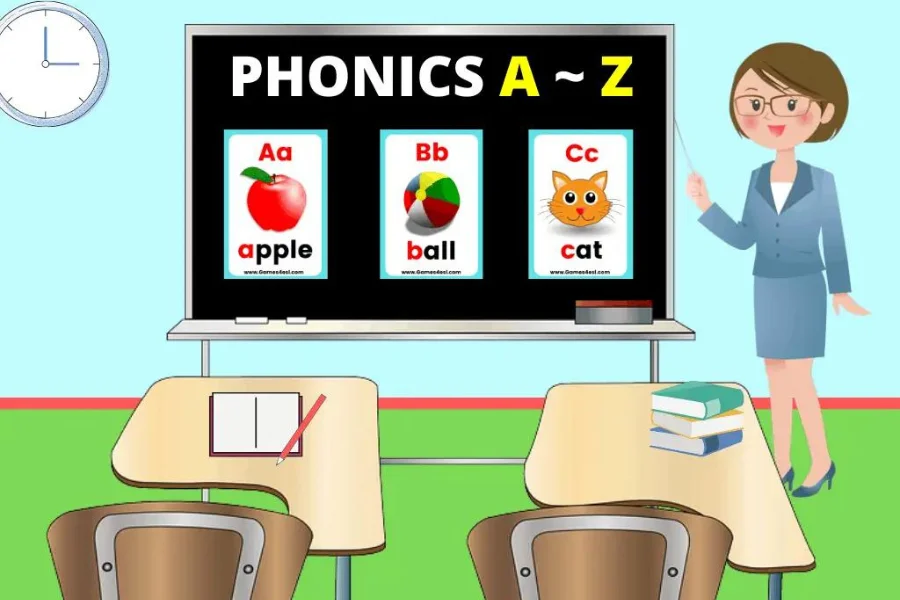
Source: games4esl
Mastering Phonics is an important skill for reading and writing, as it helps children comprehend the association between letters and sounds. To Master Phonics, start by understanding the sounds each letter makes, concentrating on short vowels and common consonants. Once acquainted with these sounds, practice blending them together to form simple words.
As you progress, break down words into individual sounds to improve spelling, and gradually introduce more complex patterns such as digraphs and consonant blends. It will become natural and enjoyable to Master Phonics through consistent practice and engaging activities.
How to Teach Phonics at Home?
It can be an enjoyable and rewarding experience to Teach Phonics at Home for both you and your child. By pursuing a methodical approach, you can help your child Master Phonics and develop essential reading and writing aptitudes.
Here’s a stepwise guide on How to Teach Phonics at Home:
Build Phonemic Understanding
Start by engaging in sound games that focus on phonemic awareness. These activities don’t require letter symbols but instead emphasize the sounds (phonemes) in spoken words. This is an important foundation for helping your child understand that letters represent speech sounds.
Connect Letter Symbols and Speech Sounds
Once your child has acquired some phonemic understanding, let them associate the sounds in words with their written letter symbols. Focus on the beginning sounds of words, and use means like Montessori sandpaper letters to help your child build associations through muscular, visual, and auditory memory.
Apply Phonics Knowledge to Build Words
Use a Montessori moveable alphabet to help your Child Learn to Build Words by arranging letter symbols that represent speech sounds. This step allows your child to apply their phonics knowledge to express ideas in writing.
Use Phonics Understanding to Decode Words
As your child builds a solid familiarity with phonics, they will begin to decode words. Encourage regular practice with word-building activities and simple reading materials. Additionally, familiarizing sight words will support fluency, and decodable readers will help strengthen their decoding skills.
You can effectively Teach Phonics at Home by following these steps, helping your child Master Phonics and become a confident reader and writer.

Source: freepik
Fun & Fast Way to Master Phonics
Mastering phonics need not be a slow or dull process. There are Fun & Fast Ways to help children Master Phonics skills while keeping them involved and enthusiastic.
Let us look at the Fun & Fast Way to Master Phonics:
Do Letter Puzzles
Use printable letter puzzles or letter flashcards to have children match objects to corresponding letters. This activity strengthens letter and sound recognition. You can also use flashcards to match letters with sounds or words.
Play “I Spy”
This is an entertaining game that pushes children to think about sounds and spelling patterns. For example, you could say, “I spy something that starts with the /d/ sound,” and let them guess the word. It fosters awareness of phonetic patterns and sound associations in words.
Incorporate Rhymes
Rhymes help strengthen letter sounds and word patterns. Incorporate catchy preschool rhymes such as Twinkle Twinkle Little Star or One Two Buckle My Shoe during reading time. Rhyming books or chants can also be integrated into circle time to improve sound recognition.
Practice Blending
Blending sounds is a key skill in phonics. Help children practice combining individual letter sounds to form words. For example, show them the letters /t/, /a/, and /p/ and have them blend them together to say “tap.”
Alphabet Sound Race
Add a physical twist to learning with an alphabet sound race. Scatter letter blocks or magnets across the room. Call out a letter, and have children pick it out, bring it to you, and pronounce the sound. You can also make it a word-building race to strengthen word recognition and phonics skills.
Letter Sorting
Sorting letters by shape is a fun way to differentiate letter names and sounds. Use magnetic letters or printed ones and have children sort them into categories like “curved” and “straight” letters. This reinforces both letter recognition and phonetic awareness.
Letter Match
In a letter match activity, pair up children with letter and image cards. Invite them to find the matching letter and image, such as matching the letter “c” with an image of a cup. This activity helps children remember the association between letters and the sounds they make.
These easy, entertaining activities provide a compelling way to help children Master Phonics. By mixing learning with play, your child will develop key reading and writing skills while having fun!

Source: readingeggs
How can I Improve my Phonics Teaching?
Improve Phonics Teaching by enriching your students’ reading and writing proficiency. Whether you’re a new teacher or an adept educator looking to polish your approaches, there are several methods you can adopt to become more effective. One fantastic way to build a strong foundation is by joining a Phonics Teacher Training Course.
Here’s how you can Improve Phonics Teaching:
Understand Phonics Principles
A concrete grasp of phonics fundamentals is important. Take the time to learn how letter sounds work, blending, and how these skills help with word decoding. The more you understand the principles, the finer you can teach them.
Combine Interactive Games and Activities
When children are actively involved, they learn the best. Use games, jingles, and exercises like letter puzzles, rhyming games, or flashcards to make phonics lessons entertaining and engaging. These approaches help strengthen letter-sound associations and promote active participation.
Use a Miscellany of Learning Materials
Different students have different learning patterns. Some may benefit from pictorial aids, while others respond better to auditory or kinaesthetic activities. Ensure you are using a miscellany of materials, such as flashcards, worksheets, books, digital aids, etc., to cater to various learning styles.
Focus on Progression
Start with the basic letter sounds and slowly advance to more intricate phonetic concepts of digraphs and blends. It’s important to build a firm foundation before moving to more detailed concepts. Regular assessment of previous material helps strengthen what students have already learned.
Seek Professional Development
One of the best methods to Improve Phonics Teaching is by joining a Phonics Teacher Training Course. A course like the one presented by Vidhyanidhi Education Society (Govt. Regd.) can equip you with the knowledge, tools, and strategies needed to Master Phonics and teach effectively. You will learn how to streamline your lessons, evaluate student progress, and use technical methods to help different learners.
Monitor and Assess Progress
Regularly evaluate your students’ phonics skills to identify areas where they may need further support. Use both formal and informal assessments to follow their progress and adapt your teaching methods accordingly.
Create a Cheerful Learning Environment
Encourage a growth mindset by praising effort and improvement, not just success. A positive, supportive classroom setting helps students feel confident as they understand and Master Phonics skills.
By using these strategies and continuing your professional advancement, you can Improve Phonics Teaching. A Phonics Teacher Training Course can equip you with the skills and confidence needed to Master Phonics and support your students on their learning journey.
Join Vidhyanidhi Education Society’s Phonics Teacher Course and transform teaching into lifelong literacy!
For any course-related info, dial +919869546913 / +919869866277.
Download Phonics Teacher Course Brochure Here.
FAQs
Why do I struggle with Phonics?
Struggling with phonics could stem from difficulty associating sounds with letters, insufficient practice, or learning disparities that need tailored strategies.
What Are The Hardest Phonics Sounds?
The hardest phonics sounds include digraphs like "sh," "ch," and "th," as well as vowel combinations like "ai" or "ea," which can have multiple pronunciations.
What Is A Tricky Word in Phonics?
A tricky word in phonics does not follow typical spelling rules, like "though" or "said," where the pronunciation doesn't match the expected pattern.



